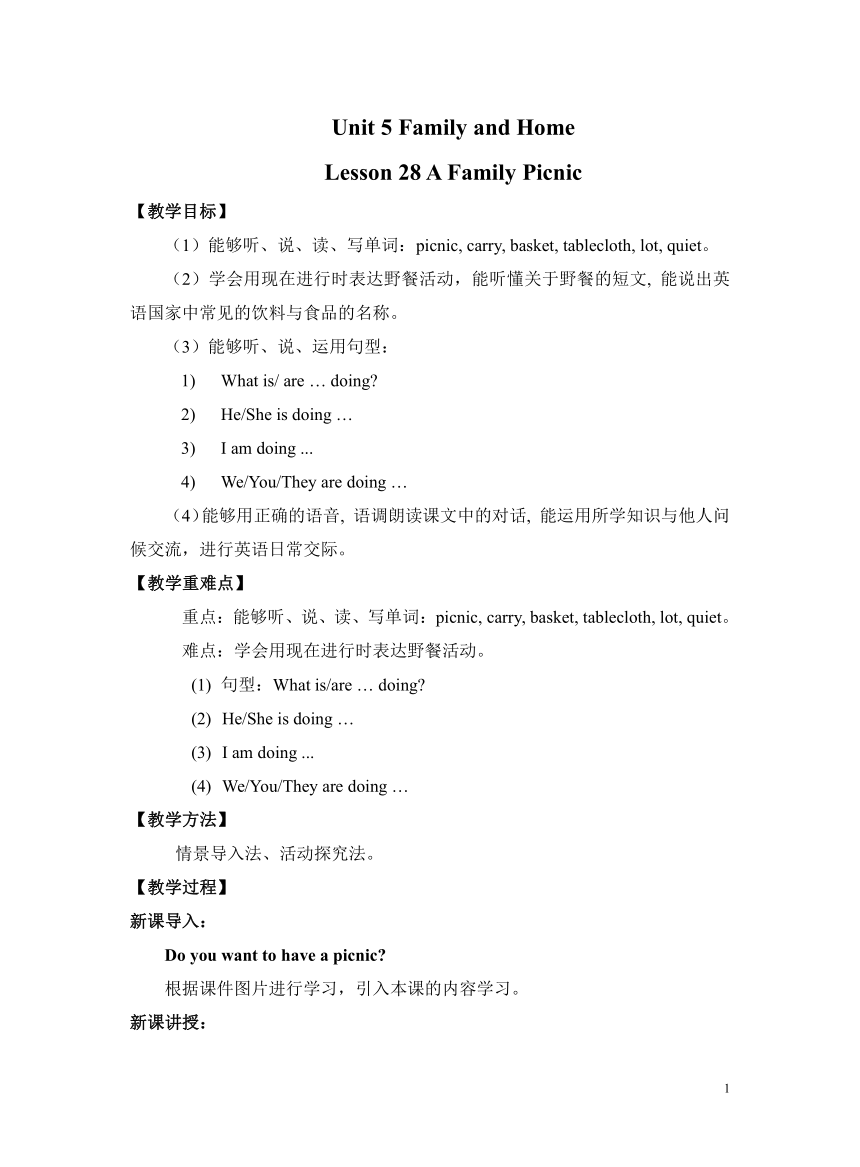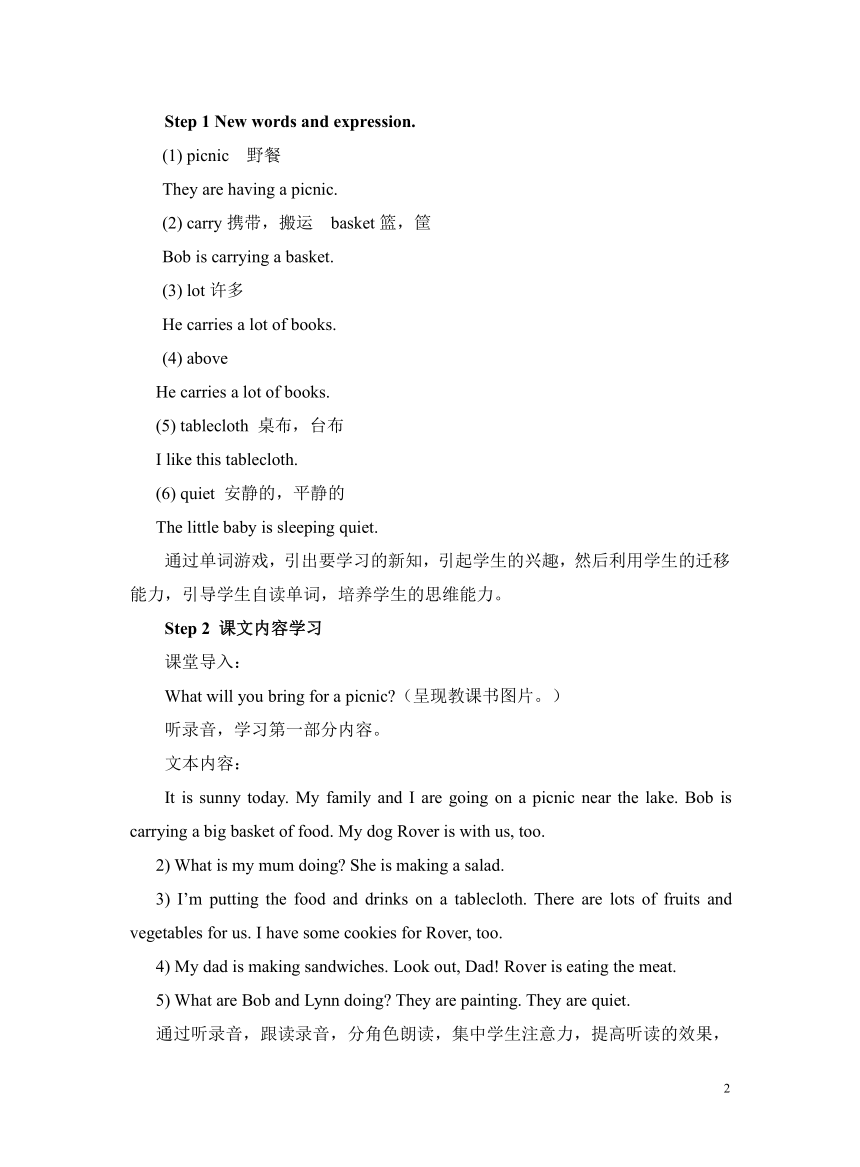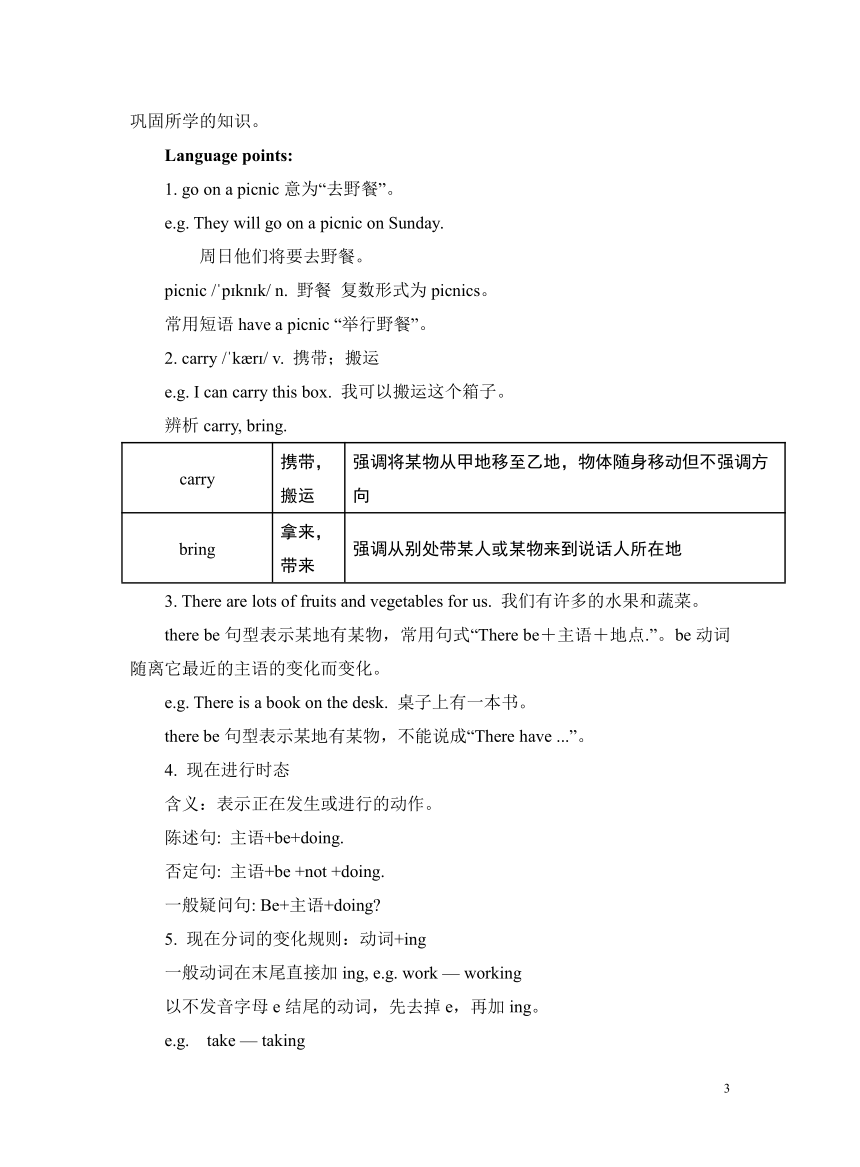冀教版英语七年级上册 Unit 5 Family and Home Lesson 28 A Family Picnic 教案
文档属性
| 名称 | 冀教版英语七年级上册 Unit 5 Family and Home Lesson 28 A Family Picnic 教案 |  | |
| 格式 | docx | ||
| 文件大小 | 22.9KB | ||
| 资源类型 | 教案 | ||
| 版本资源 | 冀教版 | ||
| 科目 | 英语 | ||
| 更新时间 | 2023-09-06 22:48:04 | ||
图片预览



文档简介
Unit 5 Family and Home
Lesson 28 A Family Picnic
【教学目标】
(1)能够听、说、读、写单词:picnic, carry, basket, tablecloth, lot, quiet。
(2)学会用现在进行时表达野餐活动,能听懂关于野餐的短文, 能说出英语国家中常见的饮料与食品的名称。
(3)能够听、说、运用句型:
What is/ are … doing
He/She is doing …
I am doing ...
We/You/They are doing …
(4)能够用正确的语音, 语调朗读课文中的对话, 能运用所学知识与他人问候交流,进行英语日常交际。
【教学重难点】
重点:能够听、说、读、写单词:picnic, carry, basket, tablecloth, lot, quiet。
难点:学会用现在进行时表达野餐活动。
句型:What is/are … doing
He/She is doing …
I am doing ...
We/You/They are doing …
【教学方法】
情景导入法、活动探究法。
【教学过程】
新课导入:
Do you want to have a picnic
根据课件图片进行学习,引入本课的内容学习。
新课讲授:
Step 1 New words and expression.
(1) picnic 野餐
They are having a picnic.
(2) carry携带,搬运 basket篮,筐
Bob is carrying a basket.
(3) lot许多
He carries a lot of books.
(4) above
He carries a lot of books.
(5) tablecloth 桌布,台布
I like this tablecloth.
(6) quiet 安静的,平静的
The little baby is sleeping quiet.
通过单词游戏,引出要学习的新知,引起学生的兴趣,然后利用学生的迁移能力,引导学生自读单词,培养学生的思维能力。
Step 2 课文内容学习
课堂导入:
What will you bring for a picnic (呈现教课书图片。)
听录音,学习第一部分内容。
文本内容:
It is sunny today. My family and I are going on a picnic near the lake. Bob is carrying a big basket of food. My dog Rover is with us, too.
2) What is my mum doing She is making a salad.
3) I’m putting the food and drinks on a tablecloth. There are lots of fruits and vegetables for us. I have some cookies for Rover, too.
4) My dad is making sandwiches. Look out, Dad! Rover is eating the meat.
5) What are Bob and Lynn doing They are painting. They are quiet.
通过听录音,跟读录音,分角色朗读,集中学生注意力,提高听读的效果,巩固所学的知识。
Language points:
1. go on a picnic意为“去野餐”。
e.g. They will go on a picnic on Sunday.
周日他们将要去野餐。
picnic / p kn k/ n. 野餐 复数形式为picnics。
常用短语have a picnic “举行野餐”。
2. carry / k r / v. 携带;搬运
e.g. I can carry this box. 我可以搬运这个箱子。
辨析carry, bring.
carry 携带, 搬运 强调将某物从甲地移至乙地,物体随身移动但不强调方向
bring 拿来, 带来 强调从别处带某人或某物来到说话人所在地
3. There are lots of fruits and vegetables for us. 我们有许多的水果和蔬菜。
there be句型表示某地有某物,常用句式“There be+主语+地点.”。be动词随离它最近的主语的变化而变化。
e.g. There is a book on the desk. 桌子上有一本书。
there be句型表示某地有某物,不能说成“There have ...”。
4. 现在进行时态
含义:表示正在发生或进行的动作。
陈述句: 主语+be+doing.
否定句: 主语+be +not +doing.
一般疑问句: Be+主语+doing
5. 现在分词的变化规则:动词+ing
一般动词在末尾直接加ing, e.g. work — working
以不发音字母e结尾的动词,先去掉e,再加ing。
e.g. take — taking
以辅音字母结尾的重读闭音节中,先双写这个辅音字母,再加ing。
e.g. put — putting
Step 3 Let’s Do It!
1. Listen and number the pictures.
2. Read the lesson and match the people with the actions.
3. Work in pairs. Look at the pictures in this lesson.
What are Jenny and her family doing Talk about it.
4. What do you and your family like to do together
Group work:
A guessing game 我做你猜
One student acts and others guess what he/she is doing.
(一名同学上台表演,其余同学进行猜测)
Example:
A: What is he/she doing
B: He/She is ...
课堂练习:
一、用所给词的正确形式填空
1. What _____ (be) he doing
2. She _____ (be) crying.
3. They _____ (be) working.
4. We are _________(make) salad.
5. What are you _______ (do)
二、单项选择
1. The student _____ an English class.
A. have B. having C. is having
2. —What ___ your sister doing
—She _____ cleaning the floor.
A. are, is B. does, is C. is, is
3. There ______ a pencil and some pens in the box. (绥化)
A. is B. are C. aren’t
三、按要求改写句子。
1. She is singing. (改为否定句)
__________________________
2. We are making dumplings. (一般疑问句)
___________________________
3. Lily is laughing. (对划线部分提问)
__________________________
课堂小结:
T: What did you learn about this lesson
学生自由说,教师总结。
语言知识:
1) 识记以下单词: picnic, carry, basket, tablecloth, lot, quiet
2) 掌握短语及句型:
What is/are … doing
He/She is doing …
I am doing ...
We/You/They are doing …
语言技能:
1)能运用所学知识与他人问候交流。
2)听懂并能进行英语日常交际。
将本节课所学的知识进行归纳,帮助学生理解和记忆,巩固提升本课时所学的知识。
作业布置:
完成配套课后练习。
【板书设计】
Unit 5 Family and Home
Lesson 28 A Family Picnic
picnic, carry, basket, tablecloth, lot, quiet
What is/are … doing /He/She is doing …
I am doing ... / We/You/They are doing …
【课后反思】
本课时的教学内容是冀教版七年级上册英语第五单元的第四课时, 重点在于引导学生理解语境, 从“野餐”开始, 自然地导入一家人去野餐的话题。以如何野餐作为任务引起学生的听说兴趣, 训练学生的听力和口语表达能力。利用实物或图片学习英语单词, 同时在对话中反复运用新学的单词和短语。因此, 教师可以将知识目标定为掌握本课时新出现的词和短语, 如何在户外野餐的句型。
1
Lesson 28 A Family Picnic
【教学目标】
(1)能够听、说、读、写单词:picnic, carry, basket, tablecloth, lot, quiet。
(2)学会用现在进行时表达野餐活动,能听懂关于野餐的短文, 能说出英语国家中常见的饮料与食品的名称。
(3)能够听、说、运用句型:
What is/ are … doing
He/She is doing …
I am doing ...
We/You/They are doing …
(4)能够用正确的语音, 语调朗读课文中的对话, 能运用所学知识与他人问候交流,进行英语日常交际。
【教学重难点】
重点:能够听、说、读、写单词:picnic, carry, basket, tablecloth, lot, quiet。
难点:学会用现在进行时表达野餐活动。
句型:What is/are … doing
He/She is doing …
I am doing ...
We/You/They are doing …
【教学方法】
情景导入法、活动探究法。
【教学过程】
新课导入:
Do you want to have a picnic
根据课件图片进行学习,引入本课的内容学习。
新课讲授:
Step 1 New words and expression.
(1) picnic 野餐
They are having a picnic.
(2) carry携带,搬运 basket篮,筐
Bob is carrying a basket.
(3) lot许多
He carries a lot of books.
(4) above
He carries a lot of books.
(5) tablecloth 桌布,台布
I like this tablecloth.
(6) quiet 安静的,平静的
The little baby is sleeping quiet.
通过单词游戏,引出要学习的新知,引起学生的兴趣,然后利用学生的迁移能力,引导学生自读单词,培养学生的思维能力。
Step 2 课文内容学习
课堂导入:
What will you bring for a picnic (呈现教课书图片。)
听录音,学习第一部分内容。
文本内容:
It is sunny today. My family and I are going on a picnic near the lake. Bob is carrying a big basket of food. My dog Rover is with us, too.
2) What is my mum doing She is making a salad.
3) I’m putting the food and drinks on a tablecloth. There are lots of fruits and vegetables for us. I have some cookies for Rover, too.
4) My dad is making sandwiches. Look out, Dad! Rover is eating the meat.
5) What are Bob and Lynn doing They are painting. They are quiet.
通过听录音,跟读录音,分角色朗读,集中学生注意力,提高听读的效果,巩固所学的知识。
Language points:
1. go on a picnic意为“去野餐”。
e.g. They will go on a picnic on Sunday.
周日他们将要去野餐。
picnic / p kn k/ n. 野餐 复数形式为picnics。
常用短语have a picnic “举行野餐”。
2. carry / k r / v. 携带;搬运
e.g. I can carry this box. 我可以搬运这个箱子。
辨析carry, bring.
carry 携带, 搬运 强调将某物从甲地移至乙地,物体随身移动但不强调方向
bring 拿来, 带来 强调从别处带某人或某物来到说话人所在地
3. There are lots of fruits and vegetables for us. 我们有许多的水果和蔬菜。
there be句型表示某地有某物,常用句式“There be+主语+地点.”。be动词随离它最近的主语的变化而变化。
e.g. There is a book on the desk. 桌子上有一本书。
there be句型表示某地有某物,不能说成“There have ...”。
4. 现在进行时态
含义:表示正在发生或进行的动作。
陈述句: 主语+be+doing.
否定句: 主语+be +not +doing.
一般疑问句: Be+主语+doing
5. 现在分词的变化规则:动词+ing
一般动词在末尾直接加ing, e.g. work — working
以不发音字母e结尾的动词,先去掉e,再加ing。
e.g. take — taking
以辅音字母结尾的重读闭音节中,先双写这个辅音字母,再加ing。
e.g. put — putting
Step 3 Let’s Do It!
1. Listen and number the pictures.
2. Read the lesson and match the people with the actions.
3. Work in pairs. Look at the pictures in this lesson.
What are Jenny and her family doing Talk about it.
4. What do you and your family like to do together
Group work:
A guessing game 我做你猜
One student acts and others guess what he/she is doing.
(一名同学上台表演,其余同学进行猜测)
Example:
A: What is he/she doing
B: He/She is ...
课堂练习:
一、用所给词的正确形式填空
1. What _____ (be) he doing
2. She _____ (be) crying.
3. They _____ (be) working.
4. We are _________(make) salad.
5. What are you _______ (do)
二、单项选择
1. The student _____ an English class.
A. have B. having C. is having
2. —What ___ your sister doing
—She _____ cleaning the floor.
A. are, is B. does, is C. is, is
3. There ______ a pencil and some pens in the box. (绥化)
A. is B. are C. aren’t
三、按要求改写句子。
1. She is singing. (改为否定句)
__________________________
2. We are making dumplings. (一般疑问句)
___________________________
3. Lily is laughing. (对划线部分提问)
__________________________
课堂小结:
T: What did you learn about this lesson
学生自由说,教师总结。
语言知识:
1) 识记以下单词: picnic, carry, basket, tablecloth, lot, quiet
2) 掌握短语及句型:
What is/are … doing
He/She is doing …
I am doing ...
We/You/They are doing …
语言技能:
1)能运用所学知识与他人问候交流。
2)听懂并能进行英语日常交际。
将本节课所学的知识进行归纳,帮助学生理解和记忆,巩固提升本课时所学的知识。
作业布置:
完成配套课后练习。
【板书设计】
Unit 5 Family and Home
Lesson 28 A Family Picnic
picnic, carry, basket, tablecloth, lot, quiet
What is/are … doing /He/She is doing …
I am doing ... / We/You/They are doing …
【课后反思】
本课时的教学内容是冀教版七年级上册英语第五单元的第四课时, 重点在于引导学生理解语境, 从“野餐”开始, 自然地导入一家人去野餐的话题。以如何野餐作为任务引起学生的听说兴趣, 训练学生的听力和口语表达能力。利用实物或图片学习英语单词, 同时在对话中反复运用新学的单词和短语。因此, 教师可以将知识目标定为掌握本课时新出现的词和短语, 如何在户外野餐的句型。
1
同课章节目录
- Unit 1 School and friends
- Lesson 1 Hello!
- Lesson 2 Teacher and Students
- Lesson 3 Welcome to Our School
- Lesson 4 What Is It?
- Lesson 5 May I Have a Book?
- Lesson 6 Things for School
- Unit 2 Colours and Clothes
- Lesson 7 Jenny's New Skirt
- Lesson 8 Danny's Favourit Colou
- Lesson 9 Whose Coat Is This?
- Lesson 10 Clothes for a Cold Day
- Lesson 11 Clothes around the World
- Lesson 12 Let's Go Shopping!
- Unit 3 Body Parts and Feelings
- Lesson 13 Body Parts
- Lesson 14 Colours and Feelings
- Lesson 15 Tall or Short
- Lesson 16 Happy or Sad
- Lesson 17 Seeing a Docto
- Lesson 18 We All Look Different!
- Unit 4 Food and Restaurants
- Lesson 19 Time for Breakfast!
- Lesson 20 I Like the Supermarket!
- Lesson 21 At the Market
- Lesson 22 In the Restaurant
- Lesson 23 The Corner Store
- Lesson 24 Eat Good Food!
- Unit 5 Family and Home
- Lesson 25 Jenny's Family
- Lesson 26 Li Ming's Family
- Lesson 27 Danny at Home
- Lesson 28 A Family Picnic
- Lesson 29 A Birthday Card
- Lesson 30 Grandma's Birthday Party
- Unit 6 Let's Go!
- Lesson 31 Let's Go to the Bookstore!
- Lesson 32 At the Supermarket
- Lesson 33 Let's Go to the Zoo!
- Lesson 34 On the Farm
- Lesson 35 Let's Go to the Museum!
- Lesson 36 Let's Go to the Movie Theatre!
- Unit 7 Days and Months
- Lesson 37 Seasons and Weathe
- Lesson 38 Nick's Busy Month
- Lesson 39 A Class Calenda
- Lesson 40 When Is Your Birthday?
- Lesson 41 Holidays
- Lesson 42 Happy Holidays!
- Unit 8 Countries around the world
- Lesson 43 Directions
- Lesson 44 Jack's Goodbye Party
- Lesson 45 China
- Lesson 46 Canada and the U.S.
- Lesson 47 The U.K. and Australia
- Lesson 48 English-Speaking Countries
